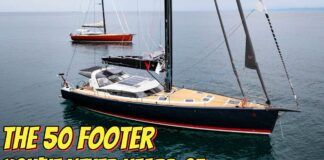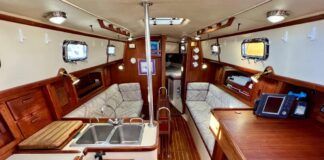When shopping for a new stereo system, be sure to evaluate the following closely to be sure the package meets your needs.
· Power amplifier: Also called the head unit, the amplifier boosts signals from preamplifiers with enough audio power to move the speaker cones. There are two different measurements for amplifier power output capacity: peak output and root-mean-squared (RMS) output. Peak output is the maximum power produced; this is usually not sustained without distortion or damage to components. RMS output is the average power an amp can produce over time (typically 15 to 20 watts per channel).
The Federal Communications Commission requires makers list a stereo’s RMS output. However, beware that makers may also advertise output in “peak”, “RMS” or “rated” watts, or total watts instead of per-channel—and won’t say which it is.
More RMS power means you can boost up the volume without noticeable distortion. A quality marine stereo will have at least 40 to 50 watts peak output, and unless you want the booming bass of the “1812 Overture” cannons, you can get by with 10 to 15 watts RMS per channel. Owners of larger boats don’t necessarily need more power, but they may want to install an additional amplifier and more speakers to cover a larger area.
When shopping for a stereo, compare RMS power rather than peak. It’s a better indicator of potential sound quality.
· Control/display panel: The LCD display often features backlighting, a clock, and song or channel information, such as what track is being played and the artist or album. Marine stereos with CD players should have sealed gaskets at the opening to prevent water intrusion. Buttons and the display should be water-resistant as well. This will help ensure a longer service life.
· Speaker type: Speakers convert analog electrical energy into sound by moving diaphragms (cones), which in turn move air. Most home and car stereo speakers use paper cones, while marine stereos should have polypropylene cones, which will withstand moist environments much better than paper. However, even these aren’t likely to last the long haul, and buyers can expect to replace them every two to four years.
Speaker quality depends primarily on frequency range. The range a speaker can reproduce has to do with what type of speaker it is. There are four kinds: dual cone, coaxial, component, and subwoofers. Dual cone speakers have one sound output source, but deliver sound using a small cone for high frequencies and a large cone for mid-range and low frequencies. A coaxial speaker essentially a woofer (for mid and low frequencies) wrapped around a tweeter (for high frequencies). Typically, coaxial speakers offer better sound than dual cone. In component speakers, the tweeter and woofer are separate. The benefit of this is less cross-phase distortion. The subwoofer handles bass frequencies. Because high-quality coaxial and component speakers can also offer deep bass, installing a dedicated woofer would be overkill on most boats.
· Speaker power: Speakers are measured by their ability to handle power rather than by their power output. After all, the power comes from the amp, not the speakers. They are measured by their peak wattage (the max power they can handle) and RMS wattage (the average power a speaker can be expected to handle over time). Always use speakers with an RMS wattage that’s just a bit higher than the amplifier’s RMS output. Where and how the speaker is mounted also is critical. Always mount them with space behind as they need airflow and a baffle effect to work properly.
· Source inputs: These are built-in or remote and can include an AM/FM radio receiver, weather-band receiver, Sirius satellite receiver, CD player, or digital audio storage devices (MP3 players, iPods, SD cards, flash cards, etc.). Some music sources have digital outputs, so the stereo amplifier must have an input to handle it.
· Features: Typically, power and performance aren’t what distinguish stereos within a similar price range; it’s the features. While you can expect to pay more for some features (like satellite radio capability), many are considered standard (like auxiliary ports) today The question of which features are most important is a subjective one. The guy who still owns cassette tapes and lugs around books of CDs may not care a whit about iPod compatibility; and conversely, the boat owner who can’t survive without his iPhone likely isn’t interested in having a CD player, much less one that doesn’t play compressed music files like MP3s. The list of potential features is long and varies greatly depending on cost, so be sure to identify your must-have functions before shopping, lest you become mesmerized by pricey technology you may never use.




































